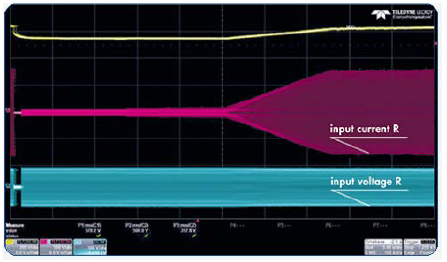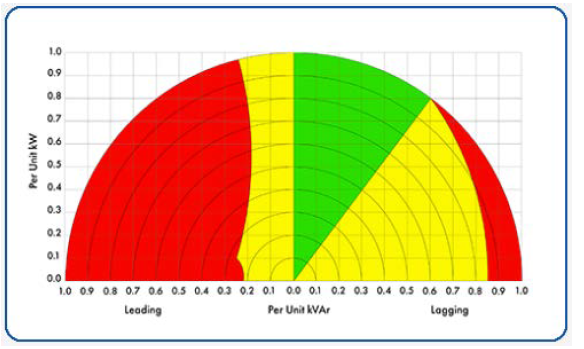UPS and generators should be best friends, smoothly cooperating to improve site’s resiliency. Often this might not be the case, due to mutual misunderstandings and lack of information. This article is a comprehensive guide and essential knowledge base about UPS input performance and its impact on generators’ operation.
In real operation, whenever a mains failure occurs, the supply is switched between incoming mains and a diesel generator set, or genset. The changeover is break-before-make, and it is usually accomplished within a few seconds. The downstream UPS system switches to battery power during the whole exchange, while its input converter, or rectifier, is off due to lack of input power. When the supply is established by the diesel generator, the rectifier performs a start-up, and the UPS operation is restored to normal double conversion. During this crucial phase it is of utmost importance that UPS and genset run like clockwork, to prevent the changeover from being jeopardized by poor interaction.
From the genset’s point of view a UPS system is a load, drawing both active and reactive power, depending on the UPS mode of operation. Up to date UPS running in VFI double conversion draw 99% “clean” real power, that is, a modern UPS is pretty much seen as a linear resistive load by the upstream supply. This simplifies a lot the design and performance of the electrical system.
In bypass operation the load is fed through the UPS bypass line by the upstream supply, which cannot thus benefit from the UPS filtering action. In this condition a genset would directly interface with the load power factor, harmonic distortion and load steps.
At light load, typically below 10% of the rated nominal power, or at no load, a UPS exhibits a predominantly capacitive input power factor and a slightly higher harmonic distortion rejection in percentage of the total absorbed power. Furthermore, the rectifier start-up transient is a load step for the upstream supply.
Although the above conditions do not impact at all the “infinite” mains power, as far as a generator set is concerned, such cases must be carefully evaluated.
As a rule of thumb, a genset continuous power rating should not be less than 1.5 times the
UPS nominal power. The oversizing factor accounts for UPS efficiency, typically 96%, UPS power factor, typically 0.99, input harmonic distortion, typically 3% and adds up a power safety margin to prevent load steps from triggering a non-stable response in the genset’s output voltage. As mentioned above, though, other parameters should be considered to ensure proper operation during transient or no-load operation.
Modern UPS do not exhibit any inrush power surge at start-ups. They gradually ramp-up to the required output power according to an adjustable “walk-in” time. This is the so called “soft-start” feature, which can also comprise a delayed start-up according to an adjustable “hold-off” time. Setting a hold-off time is useful when more UPS units are starting in parallel, so that the total UPS load is applied in gradual steps to the genset.
On the other hand, walk-in time relates to how steep the soft-start ramp will be. The shorter the setting, the steeper the ramp. It is important to note, that during the combined hold-off and walk-in time, the rectifier is not fully powered to supply the load, thus the storage batteries might still be partially discharging.

On top of that, battery charging inhibition might be in place to assist the genset in gradual load ramping. Among other factors, problem-free changeovers therefore boil down to properly managing battery end of autonomy and UPS soft start settings. The latter is closely related to the specific genset output performance.
Too much CAP will stop you
Input capacitors used for filtering purpose cause pure apparent power to flow between the supply and the UPS. Such power is referred to as leading or capacitive power. Gensets can manage limited amount of pure leading power, as it interferes with the excitation circuit in the AC generator, leading to voltage oscillations and genset’s shutdown. Safe operating area charts show the allowed gensets’ load power factor range for stable operation and pure leading power limit is typically 20% of gensets’ nominal rating.

Diesel generator’s safe operating area. Normal operation is shown in green. In the yellow area operation is still possible, on temporary basis. Operation in the red area is not allowed. During UPS start-up, generators must supply pure leading power and the working point is right on the left horizontal axis. Maximum pure leading power limit is typically 0.2 of genset rated power.
A UPS system restarting after a mains failure exhibits pure input capacitive power. Although its small contribute when compared to the nominal UPS rating, at this time the input filter is not balanced by any real power. It is necessary to wait until the rectifier’s start-up to be completed. This issue is magnified when strings of paralleled UPS are to be supplied by strings of paralleled gensets. Due to the inherent sequential start-up of the generators, the very first one kicking in feeds the entire capacitive power of the UPS string. This might be exceeding the genset’s capability, thus precluding a successful changeover.
Plusieurs techniques peuvent être mises en place pour atténuer le problème, comme l'installation de bancs de résistances pour compenser, entre autres. Les onduleurs à la pointe de la technologie ont réduit leur quantité de puissance capacitive d'entrée, en mettant en œuvre les technologies de filtrage électronique des redresseurs. Ils peuvent également offrir une gestion adaptative de l'alimentation capacitive en entrée, pour aider à concevoir des infrastructures électriques plus résilientes.
Mots clés :
Catégories
récent messages
Scannez vers WeChat:everexceed
